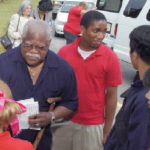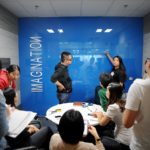By David Pego
Back in college after a 30-year absence, finally finishing his degree, the author is writing a series for the campus newspaper about what it is like to be a student of color in a university setting where there is little diversity.Imagine a large mixing bowl of something almost pure white — rice, mashed potatoes or vanilla ice cream. Now, take a pepper shaker and hold it over the bowl. Shake one time. Only. You have now created an illustration of what the racial composition of South Dakota State University (SDU) looks like. Being African American, Hispanic American, Asian American, Native American is like being a member of a minority group anywhere else in the United States. It’s a surreal experience for most of the few minority students who walk the broad white sidewalks of our Brookings campus. “I feel safe here,” said one person who is among the few people of color enrolled at SDSU. “This is not Philadelphia.” No, it’s not. We hope that fact sparks an important conversation here at SDSU — and else where. Over the next several months, The Collegian will print occasional articles on what it feels like to be a person of color here at SDSU. It will be a frank conversation that may surprise you in different ways. The first thing you should understand is that this is a unique time in the nation’s history. Together, the minority groups — particularly because of black and Hispanic population growth — are about to become the collective majority. Anglo Americans, whom we will refer to collectively as whites for ease of discussion in this series, are about to become a giant minority group of their own. Race and ethnicity — and how to pull us all together — are important topics to discuss as we rocket into the 21st Century. Students leave SDSU with diploma in hand and an unrealistic view of how they should interact with minorities. University officials know that and are aggressively trying to persuade more minorities to attend school here so the campus will be more like the “real world.” According to statistics compiled last week, there are 10,561 full- and part-time students enrolled at SDSU and its satellite campuses. Only 548 identified themselves as minorities when enrolling for classes this semester. “There are two parts to this,” said Dr. Allen Branum, head of SDSU’s Office for Diversity Enhancement. “It’s a chicken and egg sort of thing. We can’t get more minorities to come here because we don’t have minorities here and the minorities here want more minorities to come here. But we can’t get them to come here.” America is becoming increasingly influenced by the arts and lifestyles of minority cultures. SDSU dining spots offer versions of Mexican food and Asian stir-fries but the offerings are suited to a South Dakota palette, usually tasting little like the original dishes. This week, all top 10 spots on the Billboard chart for pop music belong to black recording artists, but it’s rare to hear those strains being played here as much as you would hear those songs spilling out into city streets. Here, hip hop is something rabbits do; not something that moves a whole neighborhood to dance. Being a minority and walking across campus is like being on Mars. No one looks like you. No one was raised like you. Few even talk like you do, if you came here from someplace else. No, not Mars! Forget that analogy! It’s more like being in Mayfield. Remember Mayfield? Yes, it’s that idyllic black-and-white town where Ward Cleaver and wife June raised sons Wally and Beaver. It was a black-and-white world — only it had few blacks. Or anyone else of color. Much like Brookings of 2003. “I feel that too,” Branum said. “It feels like the 1950s.” A former SDSU athletic director told Branum that the school had made several strong campaigns years ago to bring more black athletes to campus. But the efforts all failed. “He said they were very uncomfortable (on campus visits),” Branum said. “He’d introduce them to the few African-Americans we had on campus and as many brown-eyed people as he could. They’d wind up taking offers from other schools.” But many at SDSU want to change that — and not just minority students who want to see more fellow students of color. Branum and other high-ranking administrators are listening. “I wouldn’t call them complaints but I’ve had a lot of discussions about there not being enough minorities,” Branum said. “Most of those have been with faculty who are not minorities themselves. And SDSU has made another step to change that mixing bowl picture here. “We have a minority student recruiter as of this fall,” Branum said. That’s a big step forward, whether you live on Mars, Mayfield or here in Brookings. |
||
|











